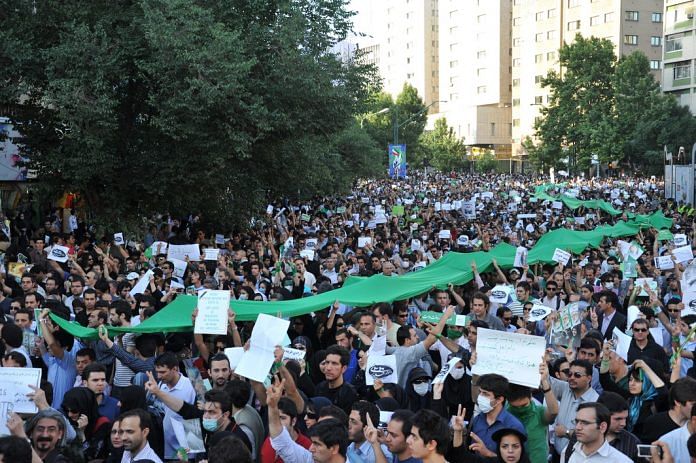The latest unrest in Iran is about something far more serious than rising gasoline prices. The proof is that, over the weekend, the regime took most of the country offline.
NetBlocks, a nongovernmental organization that monitors digital rights, says that by Saturday, Iran’s internet connectivity was 5% of what it was earlier in the week. The clampdown began on Friday, coinciding with demonstrations and protests throughout Iran, with intermittent outages in major cities such as Tehran and Shiraz. By Saturday, the group said, it had “proceeded to a disconnection of all mobile networks followed by a near-total national internet and telecommunication blackout.”
And yet the images from inside the country have kept coming. In the past few days, the rest of the world has been able to see videos from inside the country showing mass demonstrations and at times violent crackdowns from security services.
“I keep getting these videos,” says Masih Alinejad, an Iranian activist who began the anti-hijab protests and is now based in Brooklyn. Anticipating the regime’s actions, many Iranians have developed a kind of digital resilience. They take advantage of networks that remain online and at times connect to the internet through satellites or service providers in neighboring countries.
In some cases, Iranians are also taking advantage of the country’s two-tiered approach to internet access. Despite the near national blackout, regime and university networks have remained online. “The government people have internet,” says Mariam Memarsadeghi, co-founder of Tavaana, a web platform that works to build civil society inside of Iran. “There are good reasons to think the friends and families of people who have government connections will use them to get the word out.”
Abdullah Mohtadi, the secretary general of the Komala Party of Iranian Kurdistan, says Kurdish activists use Iraqi SIM cards to gain access to the Internet. The participation of the Kurds in the national protests this time also marks a change. Kurdish Iranians have protested the regime for decades, but their protests are often against the regime’s treatment of the Kurdish minority. This time, he says, Iranian Kurdish parties are coordinating their activism with the national movement.
But Alp Toker, the director of NetBlocks, warns that there is no reliable way to circumvent the regime’s restrictions. Roaming SIM cards can be cut off, he points out, while satellite internet is expensive and slow. At the same time, some apparent connections may actually be operated by the government as a ruse — tricking users into thinking their communications are safe.
The U.S. government, meanwhile, is doing what it can. It has helped fund organizations such as Memarsadaghi’s, for example. It has worked to help Iranians get access to equipment that would make it easier to get online through satellite connections instead of the on-the-ground internet service providers controlled by the regime. One U.S. official tells me that the State Department has asked some of the big social media companies to suspend the accounts of Iranian regime leaders and entities as long as Iranian citizens are kept offline. Alinejad herself has called on Twitter to shut down the personal accounts of Iran’s supreme leader, Ayatollah Ali Khamenei.
But banning Khamenei’s account, and those of other regime figures, is the least that Facebook and Twitter should do. It’s in their interest to develop easy-to-use technologies to circumvent internet bans such as Iran’s; Iranians use Twitter, Instagram, Facebook and Telegram like anyone else.
More important, the digital resilience of Iran’s freedom movement is a U.S. national security issue. It’s too soon to say whether these latest convulsions will topple a regime that has made war throughout the Middle East. But it’s clear that online activism was enough of a threat to Khamenei and his deputies that he tried to turn the internet off. The rest of the world should be grateful that so many Iranians have found ways to defy his orders. –Bloomberg
Also read: Iran has always had only one reason for its nuclear programme






